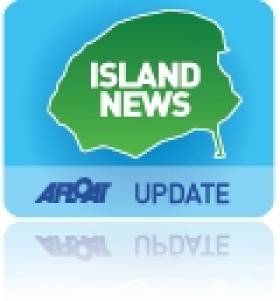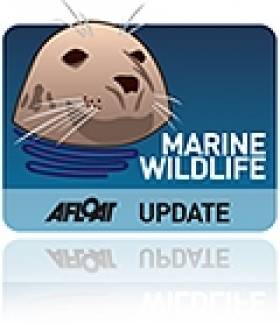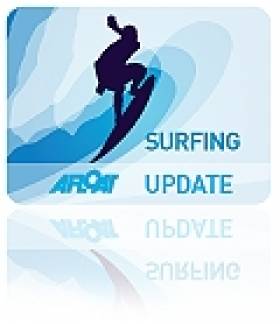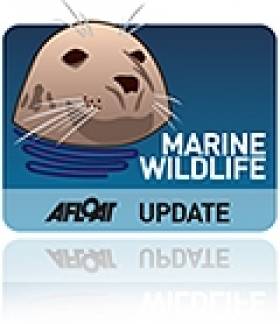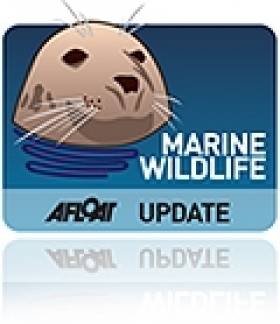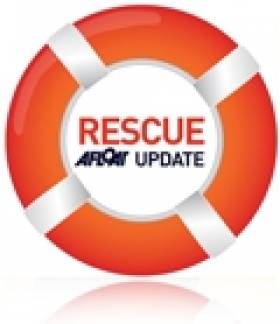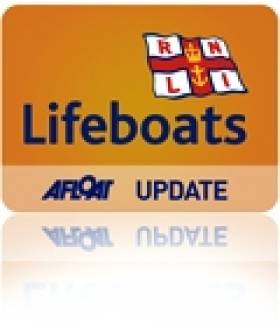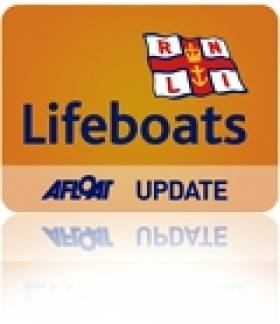Displaying items by tag: Achill Island
Achill Islander Finds Only Known Photo Of Life in 'Deserted Village'
#IslandNews - A native Achill Islander believes he's discovered the only photo of the area's famous Deserted Village taken while it was still inhabited.
As Paddy Gallagher told The Irish Times, he was searching for images of Achill online when he came across a page from a 1915 issue of National Geographic magazine with a caption suggesting it was documenting village life on the east coast.
But Gallagher knew it was a photo of the Co Mayo island, and armed with a copy of the magazine ordered from eBay he set out to find the precise location and hopefully surprise whoever was living there today.
That's when he realised it was the Deserted Village, a collection of 80 unmortared stone houses all but abandoned after the Famine by 1852, and last occupied as a 'booley village' by young farmers from nearby Dooagh in the 1940s.
However, as the photo shows, at least one family seemed to still make its home in the village a century ago.
The Irish Times has more on the story HERE.
Happy Easter For One Stranded Dolphin In Achill
#Dolphins - It was a happy Easter for one young dolphin that was rescued from stranding on Achill Island by some quick-thinking coastguard volunteers.
As TheJournal.ie reports, the juvenile dolphin was one of two reported stranded on Keem Beach early on Sunday morning.
On arrival at the scene, the local Irish Coast Guard team found one of the two had died, but officer-in-charge Colin Honeyman leapt into action to save the remaining youngster.
Taking to the sea in his wetsuit, and with some help from a nearby fishing boat, he swam with the dolphin under his arm out to deeper water, where "he seemed to get a new lease of life and just swam off - he really went for it."
TheJournal.ie has more on the story HERE.
Irish Surfing Intervarsities On Achill Island This Weekend
#Surfing - Students from all over Ireland will be taking to the waves off Achill Island for this weekend's Irish Surfing Intervarsities, as the Mayo Advertiser reports.
Keel Beach will be the venue for the two-day contest that kicks off tomorrow Saturday 22 March, and will see top wave riders from 11 institutions show their stuff in the surf - while organisers promise a party atmosphere for spectators on land. The Mayo Advertiser has more on the sorry HERE.
In other surfing news, Mullaghmore in Co Sligo will host the third annual Conference in Surfing Medicine this coming September.
According to Surfer Today, the gathering to be convened by the European Association of Surfing Doctors on 9-13 September will discuss the dangers posed by the increasingly extreme surf at one of the world's premier big wave spots.
Peter Conroy will be among those speaking during the week, giving the surfer's perspective on surfing in the harshest of conditions.
Achill Island Fin Whale Remains Could Be Big Heritage Attraction
#MarineWildlife - Achill Island locals have proposed that the 20-metre fin whale beached on Keel Beach over Christmas - and buried just before the New Year - be preserved in some form as a heritage attraction for the region, as the Galway Advertiser reports.
The inspiration comes from the residents of West Cork village Kilbrittain, who were successful in securing permissions to recover the buried remains of a similarly sized whale in 2009. The whale skeleton was since put on display as a big tourism draw.
Similar proposals by Baltimore locals in 2012 after a fin whale became trapped in the town's harbour were scuppered when Cork County Council dumped its remains at sea.
Achill Islander and Irish Whale and Dolphin Group (IWDG) member John O'Shea says that making an attraction out of the whale skeleton would connect people with the area's whaling history, which has changed profoundly over the past century from one of slaughter to preservation.
The Galway Advertiser has more on the story HERE.
'Fantastic Opportunity' To See Beached Fin Whale On Achill Island
#MarineWildlife - There's a "fantastic opportunity to witness the second largest animal on the planet close up" on Achill Island over the next few days after a male fin whale was stranded on Keel Beach on Christmas Eve.
The 20-metre-long marine giant live stranded on the beach but died some hours later, as the Irish Whale and Dolphin Group reports. It is as yet unknown what caused the fin whale to strand, but samples of skin, blubber, muscle and baleen have been taken for assessment.
TheJournal.ie repeats Achill Coast Guard's warning for anyone coming to see the whale to stay on the shore and not venture into the surf as the strongest storm in 15 years continues to sweep the country.
Driver Rescued On Achill Island As Car Goes Into Deep Water
#Rescue - The Irish Times reports on a "lucky escape" in Co Mayo yesterday (22 December) after a car plunged into deep water on Achill Island.
The driver of the vehicle was quickly rescued by the island's Irish Coast Guard unit after her car came of the road near Keel Lake in gale-force weather conditions, and was left teetering on an underwater ledge above a 25-metre drop.
Sadly a similar incident in Co Roscommon just hours before had a tragic end when the driver of a car that went into a lake could not be revived, though his passenger managed to escape the vehicle.
The Irish Times has much more on these stories HERE.
Swimmer Drowns Off Achill Island
#NewsUpdate - The Irish Times is reporting that a women has drowned while swimming off Achill Island yesterday afternoon (Thursday 10 October).
Local coastguard members responded to an emergency call just after 3pm yesterday after the woman, who was swimming with a group at the time, got into difficulty.
Her body was recovered from the water to Purteen Pier in Achill, Co Mayo, where she was pronounced dead at the scene by a local doctor.
Achill Island Welcomes Kitesurfers For Irish Tour's Last Stop
#Kitesurfing - It will be last kite flying when Ireland's kitesurfers take to the water on Achill Island this weekend 28-29 September to battle some of the best in the world at the final stop on the Irish Kitesurfing Tour Competition.
As the Mayo Advertiser reports, the kitesurfing event will be celebrated on dry land, too, with the Battle for the Lake Music and Kite Festival, as spectators watch all the action on Keel Lake - considered one of the world's best spots for the sport - and enjoy live music, a funfair and BBQ on the lakeshore.
The Mayo Advertiser has more on the story HERE.
Achill Island Lifeboat Assists Four In Two Sunday Launches
#RNLI - Achill Island RNLI responded to two separate incidents off the Mayo coast last Sunday 14 July.
The volunteer lifeboat crew was first requested to launch in the early hours of Sunday morning and again in the evening of the same day.
The crew on board the station’s all-weather lifeboat responded to a call-out a few minutes into Sunday morning when a red flare was reported to Malin Head Coast Guard Radio Station.
The flare was believed to have been seen on the Westport side of Clew Bay. The lifeboat searched the area but nothing was found and the crew returned to station at 3am.
The second incident happened at around 7.30pm when a cruiser with four people on board reported to Malin Head Coast Guard that it had engine problems and was disabled.
This was in the vicinity of Old Head on the south side of Clew Bay, and the Achill lifeboat was requested to assist the vessel.
af The casualty vessel was towed to Old Head Pier by another boat that was close by, and the lifeboat ensured that all were safe before returning to station.
RNLI Lifeboats Have Busy June Bank Holiday Weekend
#RNLI - It was a busy June bank holiday weekend around the country for RNLI lifeboats in West Cork, Mayo and the Midlands.
On Sunday afternoon, Baltimore RNLI assisted four people after their yacht got into difficulty a mile south of Mizen Head.
The 32ft yacht with four people on board had been propped by a pot buoy immobilising her in the water. The alarm was raised at 10.41am and lifeboat the Alan Massey was launched minutes later.
A local RIB, which had commenced towing, passed the tow to the lifeboat and the yacht was then taken to the safety of Crookhaven Pier.
This was the second call out this week for Baltimore RNLI. On Thursday last three men were rescued when their punt overturned near Horse Island.
Later on Sunday, Achill Island RNLI in Co Mayo brought a distressed fishing vessel with seven people on board to safety.
The volunteer lifeboat crew was requested to launch at 4.50pm to assist a small fishing vessel in the vicinity of Clew Bay and close to Clare Island. The vessel had encountered engine problems and was unable to return to port.
The boat and its crew of seven were subsequently towed safely to Curraun harbour by the Achill Island RNLI lifeboat.
Speaking after, Achill Island RNLI lifeboat operations manager Tom Honeyman said: "The presence of thick fog surrounding the vessel meant that great care was needed in the rescue and the fishing party of the vessel were delighted to return empty handed for a change."
Meanwhile in the Midlands, Lough Ree RNLI brought five people to safety in two call-outs over the weekend.
On Friday 31 May the volunteer crew was requested to launch around 5pm following a report that a cruiser had ran aground north of Quaker Island.
A local fisherman raised the alarm after spotting the cruiser on the rocks at the island located in the north end of Lough Ree raised the alarm.
The lifeboat crew managed to establish contact with the person on board the cruiser via mobile phone and he had confirmed that he had got lost and had ran aground. He reported that there was no water entering his boat. He was on his own but not injured.
The inshore lifeboat was launched and the crew was on scene at 5.30pm. It took the lifeboat 10 minutes to safely navigate its way through the rocky area to reach the casualty. The person on board the cruiser was taken to shore and arrangements were made for a specialist company to attend the scene to recover the cruiser.
Lough Ree RNLI was then launched on Sunday evening to assist a 26ft cruiser which had ran aground east of Green Island after sustaining engine failure.
The small cruiser with a family of four on board had lost engine power and had ran aground on the south east side of Lough Ree.
A crew launched the lifeboat at 8.40pm and arrived on scene 10 minutes later. After one of the lifeboat crew had carried out an assessment of the causality vessel, the decision was made to make an attempt to pull the vessel from the rocks, which the lifeboat was successfully able to complete.
Once the lifeboat had the vessel in deep water, a tow was set up and the casualty vessel was taken to Quigleys Marina in Athlone.
It marked the continuation of a dramatic week for the Lough Ree crew, after six were rescued from a sinking cruiser on the lough last Tuesday 28 May.


























